Managed moves are a voluntary agreement entered into between two schools and the parents/ carers of a pupil. They result in a pupil transferring from one school to another, often as a measure to avoid permanent exclusion.
According to Department for Education guidance, managed moves should only occur between mainstream schools, i.e. that a pupil moves from one mainstream school to another.
As they are voluntary agreements, they are not officially recorded in national data sources. Practice is thought to vary between local authorities. Many local authorities provide guidance and recommendations about managed moves to their schools within their fair access protocols. Education Policy Institute have done further research into how these vary.
In this article, we build on our previous work to try to identify pupils who have experienced managed moves using School Census data.
In part two we then examine the Key Stage 4 outcomes of one cohort of pupils who we think have experienced a managed move.
We do not claim definitively to have identified managed moves. However, we think that some of the things we have discovered in the process are worthy of wider attention.
Identifying managed moves
We identify managed moves using data from School Census in the National Pupil Database (NPD). This is a termly snapshot of all pupil enrolments in the state-funded school sector in England. It also collects (in theory), records of any pupils who have left a school since the previous Census.
We make use of the fact that pupils who experience managed moves have overlapping enrolment records in School Census. In other words, they appear to be enrolled at two schools at the same time. In many cases, such pupils will have one “main” enrolment and one “subsidiary” enrolment. In a managed move, they transfer from the school at which they have the “main” enrolment to the one at which they have the “subsidiary” enrolment.
The managed moves we identify can be split into two categories: those with explicit dual registrations and those without.
Explicit dual registration
Explicit dual registrations are cases where we observe a pupil on roll at two schools on the enumeration date for a termly Census.
Here’s an example.
This pupil undergoes a managed move from school 9994000 to school 9996900. A trial period begins on 6th January 2021. It ends on 26th March 2021 when they leave 9994000 and start attending 9996900 full-time. At this point their enrolment status at 9996900 changes from S (subsidiary) to C (current)[1]. They are explicitly dual-registered in the Spring 2021 Census.
Without explicit dual registration
Some managed moves may occur between School Censuses. For example, a managed move that begins in February (after the January School Census) and completes by the end of the April (before the Summer School Census).
In cases like this, we do not explicitly observe a period of dual registration. Instead, we would see something like this:
For this pupil, we infer that they began a managed move from school 9994001 to school 9996901 on the 7th February 2022. Between that date and the 22nd April 2022, on which they leave 9994001, they were enrolled at both 9994001 and 9996901.
Other rules
Our process for identifying managed moves relies on using entry dates and leaving dates recorded in School Census.
Where we don’t explicitly observe a dual registration, there is a risk that we infer a standard school move as a managed move when dates overlap. For such cases, we impose a minimum transition period[2] of 15 days.
We only consider moves from mainstream schools. However, we do consider moves to special and AP schools. More on this later.
We do not consider moves made by pupils who have been permanently excluded from the first school within 6 weeks of entering the second.
We do not consider moves where we have no evidence, in attendance data, that they spent any time in the second school during the move period.
Finally, we only consider moves made by pupils of compulsory school age.
Numbers of managed moves
The chart below shows the potential number of managed moves we have identified from 2014/15 to 2021/22 inclusive[3].
We identify around 6,000 potential managed moves that start each year between 2017 and 2019. This number fell considerably during the pandemic, increasing again to around 5,000 in 2022. Around 80% of them are explicit dual registrations.
The following chart summarises the ages of pupils at the start of the academic year in which their moves took place. This pattern is very similar to that for permanent exclusions.
Among the primary age groups, there are proportionately fewer explicit dual registrations. This may suggest either that a) we are incorrectly identifying some managed moves or b) transition periods tend to be shorter in primary.
In the annex, we also present some additional tables. These include length of transition periods (table 1), type of destination school (table 2) and rates by local authority (table 4).
Key points include:
- 72% of transition periods last up to 24 weeks
- 14% of transition periods last more than 40 weeks
- 75% of moves are to mainstream schools.
22% of moves are to AP schools. This includes 2/3 of those lasting more than 40 weeks. Whether these are managed moves or some other type of move is something we need to investigate a bit more.
Either way, these are moves where (typically) a pupil is dual-registered at a mainstream school and an AP school before joining the AP school full-time, without ever being permanently excluded.
Before moving on, the chart below shows the percentage of pupils who had been suspended at least once in the 12 months prior to a potential managed move.
Among primary-aged pupils, there is a difference in past suspension rates between explicit dual registrations and other cases of potential managed move. This may again suggest that we may be over-identifying managed moves in the primary sector.
In the secondary sector, differences between the two groups are smaller. Around half of secondary-aged potential managed moves involve pupils who have recently been suspended.
By way of comparison, in January 2020[4], recent suspension rates for all pupils on roll ranged from 3% for 11 year olds to 15% for 15 year olds. In other words, the group who appear to have experienced a managed move are far more likely to have recently experienced suspension.
In part two we examine outcomes for pupils who appear to have experienced a managed move.
- In practice this means being single-rolled
- The period during which a pupil is enrolled at two schools
- 2021/22 is the most recent year of exclusions data available at the time of writing
- This was before the pandemic, when numbers of suspensions fell markedly
Want to stay up-to-date with the latest research from FFT Education Datalab? Sign up to Datalab’s mailing list to get notifications about new blogposts, or to receive the team’s half-termly newsletter.






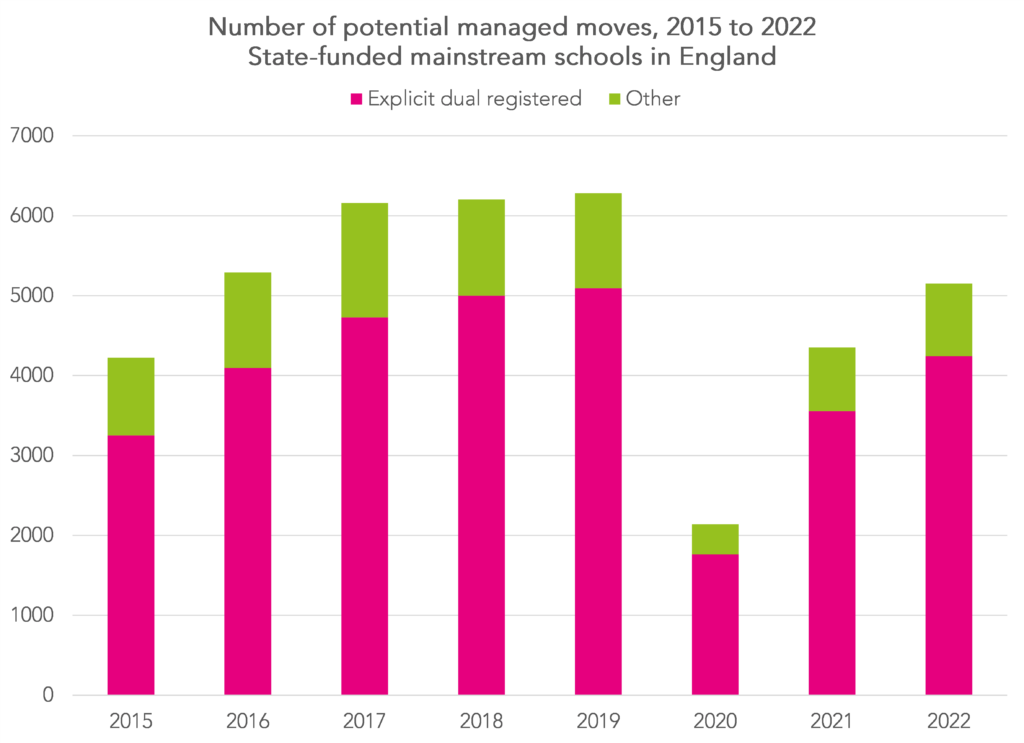
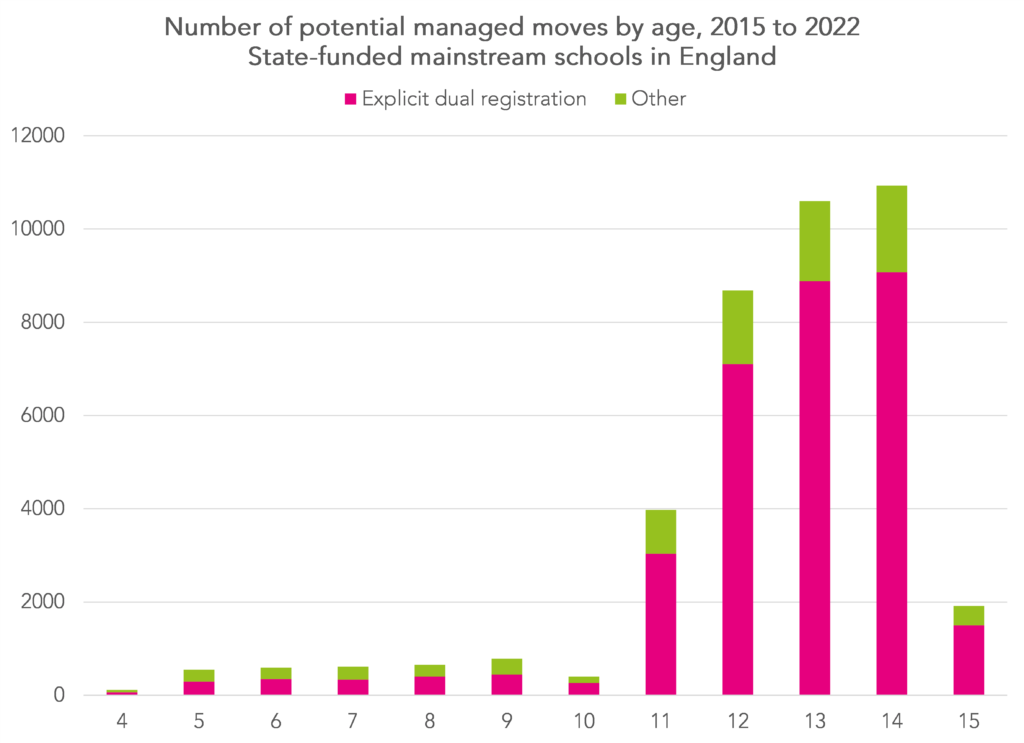
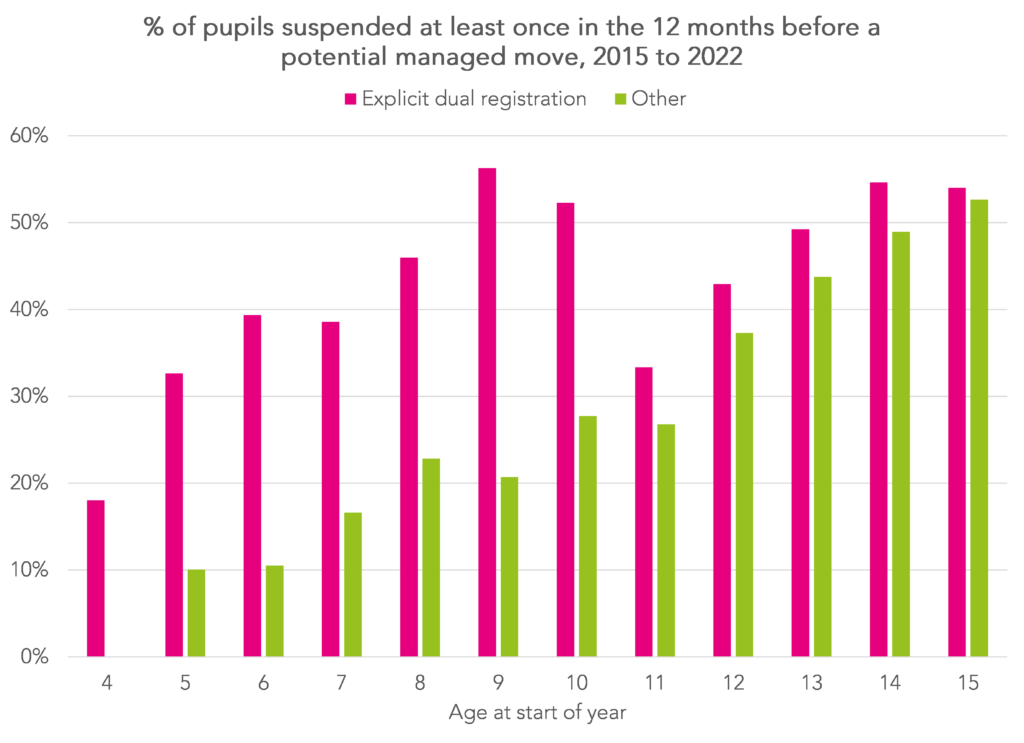
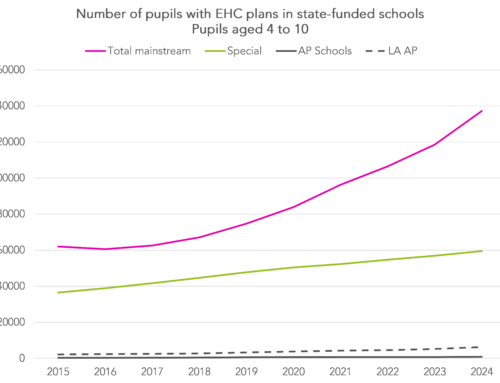
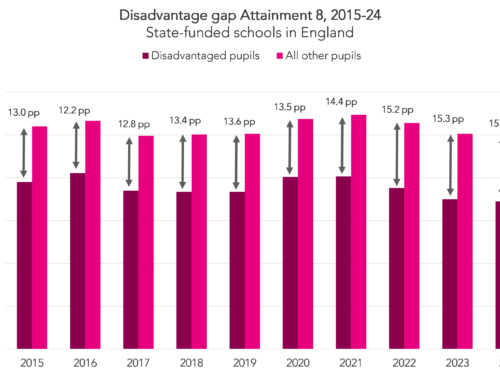



Leave A Comment